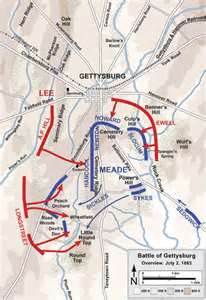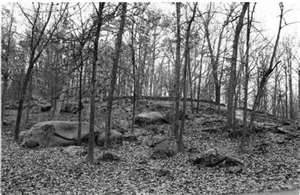The Battle of Gettysburg
Part 2: The Importance of the High Ground 
On June 30, a brigade of Hill's corps traveled the eight miles east from Cashtown to Gettysburg in order to get supplies. (One story is that they were in search of new shoes, of which many soldiers would have had great need.) The Confederate troops discovered a Union cavalry force under Brig. Gen. John Buford; neither side was looking for a fight at that time, so both withdrew. Buford's force was an advance force of the larger Union army, which Hill discovered when he sent an attack force numbering brigades the next day. Foreshadowing things to come, Buford's troops set up defense lines on three ridges west of town. The idea was to delay the Confederate advance until the full Union army arrived. With superior firepower, the Confederate troops dislodged the defenders and seized control of the town and of two of the three ridges. (An advance force of Union infantry arrived toward the end of the day, but it was not enough to repulse the Confederate advance.) Late in the day, Union forces formed a defensive position on Cemetery Hill. Seeing this, Lee ordered Ewell's forces to take the hill "if practicable." Ewell, deciding that the cost would be great, did not press the attack. At the end of the first day, Union troops were ensconced on the high ground.
Stuart and his cavalry were not back at this time, and so Lee did not have an accurate accounting of the Union forces or their positions. Longstreet advised against an assault on what he thought to be a superior Union position. The defense-minded Longstreet preferred to have the enemy come to him. Still, Lee was confident in his troops and in their ability to overcome long odds, as they had done for two years. Lee decided to attack. Longstreet was to take his First Corps and assault the Union left, with support from A.P. Hill's Third Corps. The Second Corps, under Early, was to make an assault on Culp's Hill and Cemetery Hill. The attacks were meant to happen early in the day. Various delays meant that the attacks did not begin until much later, giving Union troops time to reinforce their positions and, in some cases, move troops altogether. As a result, what was meant to be an assault by Longstreet's troops on a flank of the Union army was instead an attack on the center of the line, mainly because Maj. Gen. Daniel Sickles had marched his entire III Corps and their artillery to higher ground along nearby Emmitsburg Road. Confederate troops, when they eventually did attack, were beset on both sides. In areas known as Devil's Den and the Wheatfield, the fighting was fierce, but the result was that Union troops still held the high ground.
Fighting on the Union right flank began even later in the day, giving the defenders still more time to set up their positions. Wave after wave of attack by Early's troops were repulsed, although some Confederate troops gained control of abandoned earthworks on Culp's Hill. As a result, the Union kept possession of most of Culp's Hill and all of Cemetery Hill. In the middle of the second day, Stuart and his cavalry arrived. They played no meaningful part in the day's fighting. Next page > Pickett's Charge and Aftermath > Page 1, 2, 3 |
|
Social Studies for Kids
copyright 2002–2025
David White



 More troops from both armies arrived throughout the night of July 1 and the early morning of July 2. Union troops seized control of other hills looking over the town, among them Culp's Hill, Little Round Top, and Seminary Ridge. Meade positioned his troops in a fishhook formation, anticipating that their positions on top of various hills and ridges would give them a good defensive position if attacked. Lee's forces, meanwhile, were arrayed in a wide arc surrounding the fishhook.
More troops from both armies arrived throughout the night of July 1 and the early morning of July 2. Union troops seized control of other hills looking over the town, among them Culp's Hill, Little Round Top, and Seminary Ridge. Meade positioned his troops in a fishhook formation, anticipating that their positions on top of various hills and ridges would give them a good defensive position if attacked. Lee's forces, meanwhile, were arrayed in a wide arc surrounding the fishhook. This almost wasn't the case with Little Round Top, a target of repeated Confederate assaults. During the day, Union reinforcements numbering another brigade and a battery of artillery reinforced the troops already on top of Little Round Top, but the Union defense was a desperate one. Finally turning the tide in favor of the Union was a bayonet charge ordered by Col. Joshua Chamberlain, the commander of the 20th Maine. Surprised Confederate troops ran back down the forested hill in full retreat, and the Union defense of Little Round Top held.
This almost wasn't the case with Little Round Top, a target of repeated Confederate assaults. During the day, Union reinforcements numbering another brigade and a battery of artillery reinforced the troops already on top of Little Round Top, but the Union defense was a desperate one. Finally turning the tide in favor of the Union was a bayonet charge ordered by Col. Joshua Chamberlain, the commander of the 20th Maine. Surprised Confederate troops ran back down the forested hill in full retreat, and the Union defense of Little Round Top held.
